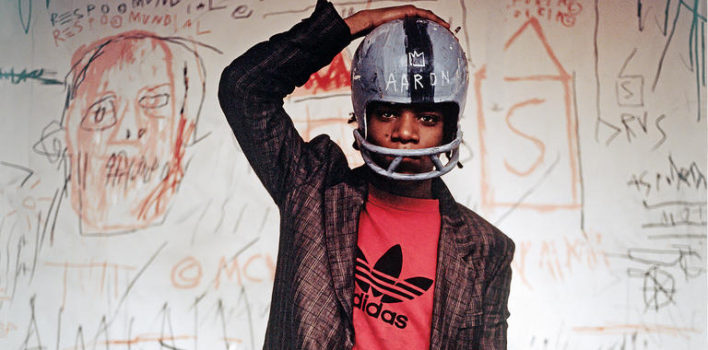Word on the Street: How Basquiat Conquered the Art World
Street art launched the career of Jean-Michel Basquiat, but in his quest for glory, did he forget the essence of what made him unique? Jessie Williams investigates…
On the way to the Barbican’s Basquiat: Boom for Real exhibition, Banksy has paid homage to his fellow graffiti artist, the late Basquiat, on the streets – the place where they both began their careers. The famously anonymous street artist depicts two Metropolitan Police Officers stopping to search a dark skeletal figure with a menacing dog at his feet. It is a reference to Basquiat’s “Boy and Dog in a Johnnypump” (1982).

In an Instagram post dripping with irony, Banksy wrote that the Barbican was usually a place that is keen to clean graffiti from its walls. It is classic Banksy; a satirical poke weaved into a serious comment on society – namely police stop and search methods. The piece, like most of his work, is now covered by Perspex. After all, it is a valuable masterpiece. In September, five Banksy murals were sold to a Qatari buyer for £3.2m.
Across the pond in May this year, Basquiat’s painting “Untitled” (1982) fetched a record-breaking £85m. In the end, the boy from Brooklyn made it big. The streets of NYC in the 70’s were both Basquiat’s playground and canvas. An intoxicating energy flows through his work, whether it’s the Picasso-esque faces of his graffiti under the guise of ‘SAMO©’ (Same Old Shit), or his visceral paintings burning with symbolism. Both Banksy and Basquiat used spray cans to make their name, but that’s where the similarities end. One prefers to remain anonymous, while the other got sucked into the very system he seemingly despised.

Basquiat’s graffiti projected a strong anti-art-world message: “SAMO© as an alternative 2 ‘playing art’ with the ‘radical chic’ of Daddy’$ funds”. Through “SAMO©, he and his friend Al Diaz, a subway graffiti artist, vented their dissatisfaction, whether it was about politics or consumerism. However, it was the art world and its tired, hegemonic ways which drew most of their criticism. They saw it as a members’ only club; a universe dominated by money. It was a universe the young Basquiat had come to orbit as a student wandering around the Museum of Modern Art in New York. He was an outsider looking in; yearning for entry into the club, hungry for fame and fortune. Graffiti was Basquiat’s ticket inside.
One of their last graffiti works declared; “SAMO© is dead”. Was this a foreshadowing of Basquiat’s early death, or the shrugging off of anonymity? In 1978, the duo sold their story of SAMO© to the Village Voice. Soon after, Basquiat’s career went boom, and he found himself rubbing shoulders with Grace Jones, Madonna, and his idol, Andy Warhol. His New York/New Wave exhibition was praised by critics; many were surprised at how his “grotty defacements” could turn into real art.
Even after he switched from concrete walls to canvases, his style remained similar; electric with an intellectual undercurrent. But he lost the rebellious spirit that was so evident in his graffiti. Yes, he still used his art to protest – particularly the stereotyping of black artists – but he no longer denounced the consumerist nature of the art world. Perhaps he didn’t want to bite the hand that was feeding him.
“Basquiat: Boom for Real” runs at the Barbican, London EC2Y, from 21st September 2017 to 28th January 2018




